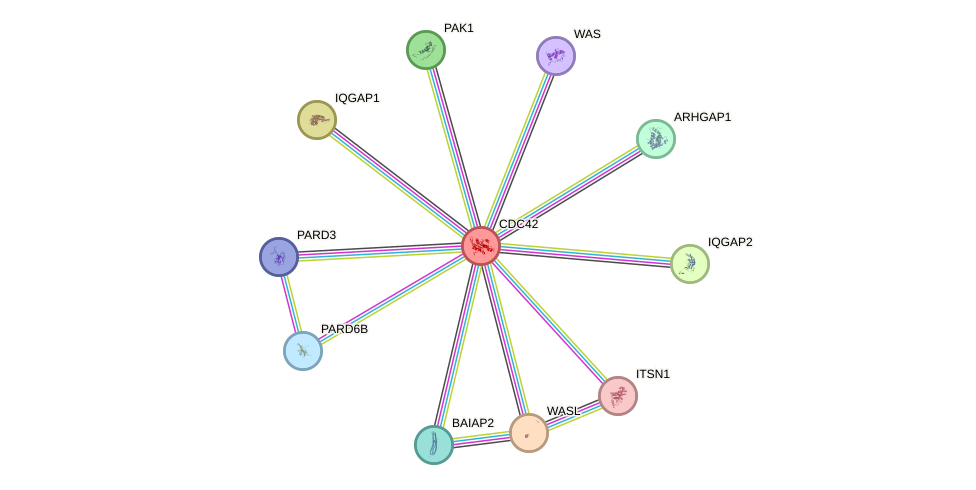GenAge entry for CDC42 (Homo sapiens)
Gene name (HAGRID: 250)
- HGNC symbol
- CDC42
- Aliases
- G25K; CDC42Hs
- Common name
- cell division cycle 42
Potential relevance to the human ageing process
- Main reason for selection
- Entry selected based on evidence directly linking the gene product to ageing in a cellular model system
- Description
CDC42 is regulates numerous signalling pathways, including cell cycle progression. Its activity increases with age in various mouse tissues. In mice, gene targeting of ARHGAP1, a negative regulator of CDC42, results in elevated levels of CDC42. The animals display multiple premature ageing-like phenotypes, suggesting this gene may play a role in mammalian ageing. CDC42 activation promotes a premature cellular senescence phenotype dependent on TP53 [1840].
Cytogenetic information
- Cytogenetic band
- 1p36.1
- Location
- 22,052,627 bp to 22,092,943 bp
- Orientation
- Plus strand
Protein information
- Gene Ontology
-
Process: GO:0002040; sprouting angiogenesis
GO:0003161; cardiac conduction system development
GO:0003334; keratinocyte development
GO:0007030; Golgi organization
GO:0007088; regulation of mitotic nuclear division
GO:0007097; nuclear migration
GO:0007163; establishment or maintenance of cell polarity
GO:0007264; small GTPase mediated signal transduction
GO:0007596; blood coagulation
GO:0010628; positive regulation of gene expression
GO:0010629; negative regulation of gene expression
GO:0016567; protein ubiquitination
GO:0021762; substantia nigra development
GO:0030036; actin cytoskeleton organization
GO:0030225; macrophage differentiation
GO:0030307; positive regulation of cell growth
GO:0031069; hair follicle morphogenesis
GO:0031274; positive regulation of pseudopodium assembly
GO:0031295; T cell costimulation
GO:0031333; negative regulation of protein complex assembly
GO:0031424; keratinization
GO:0031647; regulation of protein stability
GO:0032467; positive regulation of cytokinesis
GO:0033138; positive regulation of peptidyl-serine phosphorylation
GO:0034332; adherens junction organization
GO:0034613; cellular protein localization
GO:0035088; establishment or maintenance of apical/basal cell polarity
GO:0035264; multicellular organism growth
GO:0036336; dendritic cell migration
GO:0038096; Fc-gamma receptor signaling pathway involved in phagocytosis
GO:0039694; viral RNA genome replication
GO:0042059; negative regulation of epidermal growth factor receptor signaling pathway
GO:0042176; regulation of protein catabolic process
GO:0043497; regulation of protein heterodimerization activity
GO:0043525; positive regulation of neuron apoptotic process
GO:0043552; positive regulation of phosphatidylinositol 3-kinase activity
GO:0045740; positive regulation of DNA replication
GO:0045859; regulation of protein kinase activity
GO:0046330; positive regulation of JNK cascade
GO:0046847; filopodium assembly
GO:0048010; vascular endothelial growth factor receptor signaling pathway
GO:0048013; ephrin receptor signaling pathway
GO:0048664; neuron fate determination
GO:0051017; actin filament bundle assembly
GO:0051056; regulation of small GTPase mediated signal transduction
GO:0051149; positive regulation of muscle cell differentiation
GO:0051489; regulation of filopodium assembly
GO:0051683; establishment of Golgi localization
GO:0051835; positive regulation of synapse structural plasticity
GO:0051988; regulation of attachment of spindle microtubules to kinetochore
GO:0060047; heart contraction
GO:0060070; canonical Wnt signaling pathway
GO:0060071; Wnt signaling pathway, planar cell polarity pathway
GO:0060501; positive regulation of epithelial cell proliferation involved in lung morphogenesis
GO:0060661; submandibular salivary gland formation
GO:0060684; epithelial-mesenchymal cell signaling
GO:0060789; hair follicle placode formation
GO:0071338; positive regulation of hair follicle cell proliferation
GO:0072384; organelle transport along microtubule
GO:0090135; actin filament branching
GO:0090136; epithelial cell-cell adhesion
GO:0090316; positive regulation of intracellular protein transport
GO:1900026; positive regulation of substrate adhesion-dependent cell spreading
Cellular component: GO:0000139; Golgi membrane
GO:0000322; storage vacuole
GO:0005737; cytoplasm
GO:0005789; endoplasmic reticulum membrane
GO:0005815; microtubule organizing center
GO:0005829; cytosol
GO:0005886; plasma membrane
GO:0005911; cell-cell junction
GO:0005925; focal adhesion
GO:0016020; membrane
GO:0030141; secretory granule
GO:0030175; filopodium
GO:0030496; midbody
GO:0031256; leading edge membrane
GO:0036464; cytoplasmic ribonucleoprotein granule
GO:0043005; neuron projection
GO:0043025; neuronal cell body
GO:0043209; myelin sheath
GO:0045177; apical part of cell
GO:0051233; spindle midzone
GO:0070062; extracellular exosome
GO:0072686; mitotic spindle
Hide GO termsFunction: GO:0003924; GTPase activity
GO:0005515; protein binding
GO:0005525; GTP binding
GO:0019901; protein kinase binding
GO:0030742; GTP-dependent protein binding
GO:0031435; mitogen-activated protein kinase kinase kinase binding
GO:0031996; thioesterase binding
GO:0034191; apolipoprotein A-I receptor binding
GO:0042802; identical protein binding
GO:0051022; Rho GDP-dissociation inhibitor binding
GO:0061630; ubiquitin protein ligase activity
Protein interactions and network
- Protein-protein interacting partners in GenAge
- TP53, RAD51, TNF, ERCC3, GRB2, A2M, PRDX1, MT-CO1, MAPK8, MAPK9, DBN1, ARHGAP1, CDC42
- STRING interaction network
Retrieve sequences for CDC42
Homologs in model organisms
- Caenorhabditis elegans
- cdc-42
- Danio rerio
- cdc42
- Drosophila melanogaster
- Cdc42
- Mus musculus
- Cdc42
- Rattus norvegicus
- Cdc42
- Saccharomyces cerevisiae
- CDC42
- Schizosaccharomyces pombe
- cdc42

